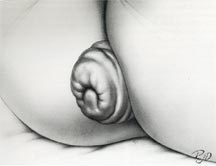Rectal Prolapse and Procidentia
IntroductionWho is at risk?
Signs and symptoms
Diagnosis
Treatment
Introduction
Rectal prolapse is a condition in which the rectum falls downwards and turns inside out. Initially, the rectum stays inside the body, but as the condition worsens, it may protrude outside through the anus. There is often weakness of the anal muscles, which may result in leakage of mucus or stool.
Incomplete rectal prolapse involves the abnormal protrusion of rectal mucosa through the anus. There is a partial overlap of this diagnosis with chronic prolapsed hemorrhoids, especially if part of the prolapse is hemorrhoids, and part of the tissue is rectal mucosa. If the protrusion of rectal mucosa is only partial, then this is called a partial mucosal prolapse.
There are two types of rectal prolapse: 1) incomplete - involving only the rectal mucosa, and 2) complete - involving both the rectal mucosa and the rectal wall - this is also called a procidentia.
Procidentia is a condition in which the rectum literally turns "inside out" and can extend as far as eight inches beyond the anus is not known. Whether weak musculature of the pelvic floor and anal canal is a cause or an effect of this condition is still a matter of controversy. A possible etiology is herniation of the cul-de-sac (a displacement of the rectum from its usually protected place in the hollow of the sacrum). In the horse, procidentia is a natural occurrence at the time of each bowel movement, but this not true in humans.

Complete rectal procidentia, showing concentric
rings of everted rectum protruding from anus.
In general, patients with rectal prolapse are seen at extreme ages, the very young and the very old.
Elderly patients may present with a history of chronic constipation or laxative abuse. They may have lax pelvic floor muscles or reduced anal sphincter tone.
In adults, partial mucosal prolapse is associated with 3rd degree hemorrhoids. In females partial or complete mucosal prolapse may be due to anal injury during delivery, or other pelvic operations.
There is also a subset of patients in the pediatric age group, usually related to toilet training problems. Infants lack a normal sacral curve, and still have undeveloped resting anal tone. Children presenting with rectal prolapse may have associated episodes of diarrhea, whooping cough, or malnutrition causing loss of ischiorectal fat. Rectal prolapse in children may be a sign of Cystic Fibrosis.
Signs and symptomsWhen a complete rectal prolapse occurs, the rectal wall protrudes and turns inside out forming concentric rings (procidentia), whereas if an incomplete prolapse occurs, only the rectal mucosa protrudes. At first, prolapse of the rectum may occur only at defecation later. It may accompany sneezing and coughing, and may also occur at any exertion. Disturbances of normal continence, mucus, bleeding, and impairment of rectal sensation are frequent. There have been reports of patients-although few-who have developed gangrene from this condition.
DiagnosisProlapse of the rectum has to be differentiated from large prolapsed hemorrhoids, polyps, or tumors. It is also important to distinguish between mucosal (incomplete) and complete prolapse. To demonstrate the prolapse, patients may be asked to "strain" as if having a bowel movement or to sit on the commode and "strain" prior to examination. Children with unexplained rectal prolapse should have a sweat chloride test to evaluate for Cystic Fibrosis. Diagnostic studies include rectal examination, sigmoidoscopy, and possibly a barium enema. Anorectal manometry may also be used. This test measures the strength of the muscles of the anus.
TreatmentA great majority of patients are completely relieved of symptoms, or are significantly helped, by the appropriate treatment. Rectal prolapse is most often a chronic condition, and can usually be reduced with the patient recumbent with gentle manual pressure. Patients should minimize their time sitting at commode, and should be maintained on a suitable stool softener pending specialty assessment.
Management of incomplete rectal prolapse in adults is similar to that of hemorrhoids. Treatment includes injection sclerotherapy, mucosal banding, or surgical restoration and plastic repair of the anus and rectum. Occasionally anal sphincter repair is required.
Procidentia in children usually can be corrected by conservative measures. These include: a nutritious diet, avoiding straining at stool, and immediate replacement of the bowel after each protrusion to avoid swelling and possible difficulty in reduction. Children frequently "outgrow" the disease as the natural curve of the sacrum becomes more concave, and surgery may not be needed.
Injections of' sclerosing agents such as 5% phenol in almond oil in the hollow of the sacrum have helped many patients with procidentia. These injections, however, should only be done by a person experienced in this procedure.
In adults with procidentia who are good-risk patients, abdominal surgery is usually indicated. There are several surgical approaches. A relatively simple operation fixes the rectum in the hollow of' the sacrum. Another method is resection and low anastomosis of the sigmoid to the rectum. In patients unable to withstand an abdominal operation, amputation and anastomosis can be performed by a perineal approach or a relatively tight purse-string non-absorbable suture to the anus. This suture, usually wire, can be placed deep to the subcutaneous tissue at the anorectal area. Local anesthesia is used.









